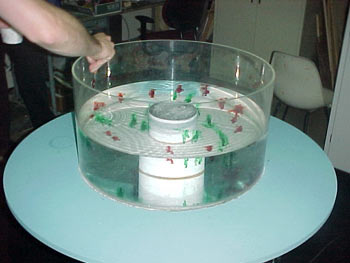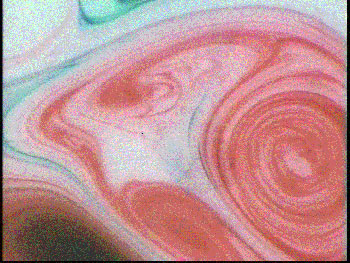Experiments: 0 | I | II | III | IV | V | VI | VII | VIII | IX | X | XI | XII | XIII | XIV
Baroclinic Instability of the Thermal Wind
The purpose of this experiment is to observe `Hadley’ and `eddying’ regimes in a differentially heated, rotating fluid annulus. The experimental arrangement is the same as in GFD Lab VIII (see figure opposite). It consists of a cylindrical plexiglass tank filled with water to a depth of about 15cm and placed on a rotating table. Initially, the water is of uniform temperature. But centered on the rotation axis, we place a metal bucket filled with ice. This sets up a radial temperature gradient (decreasing “poleward”) that will drive motions in the tank. Temperature variations in the tank are monitored at strategic positions using thermistors attached to data loggers. Currents are observed using paper dots, potassium permanganate crystals, etc.
‘Hadley’ and ’eddying’ turbulent regimes can be set up in the tank by adjusting the rotation rate, Ω, of the tank - Ω can be ranged from zero to 10 rpm.

We observe the following:
- When the table is not rotating, a simple overturning circulation is observed, with sinking at the edges of the cold can, outflow near the bottom boundary layer, and inflow aloft.
- When weakly rotating, an Ω of 0.3 rpm or less, we see the development of the thermal wind and a Hadley circulation as described in GFD Lab VIII with a single meridional overturning cell.
- If the rotation rate is increased in small increments (0.2 rpm or so) we can map the transition from axisymmetric flow through regular waves to turbulent eddies.
- When the table is rotating rapidly, an Ω of 1 rpm or more, we see the development of turbulent eddies in the tank, through baroclinic instability. The baroclinic eddies carry heat from the ’equator’ of the tank to the ‘pole’ in the center.
Here is a sequence of images showing the evolution of the flow in the fully turbulent regime:




See the movie:










